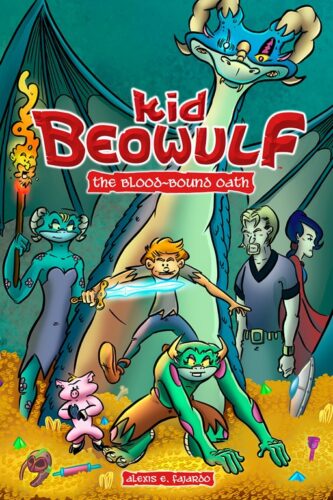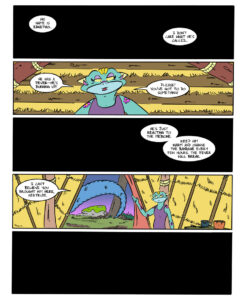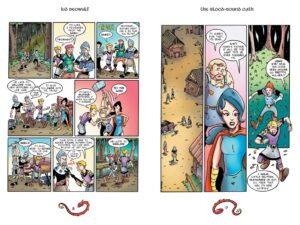 Kid Beowulf: The Blood-Bound Oath
Kid Beowulf: The Blood-Bound Oath
By Alexis E. Fajardo
Color by Jose Mari Flores
Prologue Color by Brian Kolm
Amp Comics for Kids (an imprint of Andrews McMeel Publishing)
$10.99
ISBN: 978-1-4494-7589-5
Ages 9-12
On shelves now.
This is a true story. I started college in 1996. Earlham College. Richmond, Indiana. Nice place. Little Quaker school (“Fight! Fight! Inner light! Kill, Quakers, Kill,” ← our sports chant). Little colleges have little cute traditions. Mine was keen on complicated pranks. One day I go down to the cafeteria for a bowl of Cheerios and lo and behold there, on the ceiling, is this epic mural of two cartoon characters touching fingers ala Michelangelo’s Adam and God in The Sistine Chapel. The characters in question were from a weekly comic in the school newspaper penned by one Alexis Fajardo. From that time onward I would Alexis Fajardo. And I followed his career. He kept up the comic strip (called “Plato’s Republic”) for a while and then started in on this Kid Beowulf graphic novel series. I didn’t get any chance to read them but they had a fun premise and the art really popped. Now, after all these many years, Amp Comics has picked up the series and given it a proper running start. In the grand tradition of Bone, Amulet, and countless other epic quest graphic novels, Fajardo gives us heroes to root for, villains to loathe, and complex characterizations around every turn. He’s come a long way from painting ceilings.
We start with the original epic poem of Beowulf. The original tale of man vs. monster is recounted but, the book assures us, “as men have told it – as I said, they twist the truth. Too blind to know the proper tale of a king’s run-rampant youth . . .” Now we are in the land of the Danes where a headstrong prince threatens a tenuous peace. Hrothgar cannot stand those Heathobards that he feels infringe on his homelands. When he encounters a dragon of great power he makes a deadly pact. Upon his return he begins a reign of destruction and ignorance, eventually fathering his own monstrous daughter. Named Gertrude, she is raised by the same dragon with whom Hrothgar made a pact. All this so that, in time, she will give birth to her own twins. One looks like her and is named Grendel. The other, a fully human boy, named Beowulf. And when they lose and find one another again, that’s when the story truly begins.
 One thing I didn’t really expect when I picked the book up was to encounter Fajardo’s inclination to tell his tale in his own time. By all rights, all this book is really doing from the start is setting the stage for future tales to come. Yet though it’s named “Kid Beowulf”, the titular hero and his twin brother don’t even make an appearance until page 120, and even then they’re just babies. The reader’s patience is rewarded if that reader chooses to stick with the storyline, but it means that the best kids for this book won’t be the ones who like simplified narratives of action and adventure on every other panel. No, these books are going to be for those kids who like to sink deep into a world, dwell there for a time, scope out the situations, and understand the motivations. If you’ve a new graphic novel reader on your hands, I wouldn’t start them off with Kid Beowulf. This book is better suited for those kids out there with a little comic-reading experience under their belts.
One thing I didn’t really expect when I picked the book up was to encounter Fajardo’s inclination to tell his tale in his own time. By all rights, all this book is really doing from the start is setting the stage for future tales to come. Yet though it’s named “Kid Beowulf”, the titular hero and his twin brother don’t even make an appearance until page 120, and even then they’re just babies. The reader’s patience is rewarded if that reader chooses to stick with the storyline, but it means that the best kids for this book won’t be the ones who like simplified narratives of action and adventure on every other panel. No, these books are going to be for those kids who like to sink deep into a world, dwell there for a time, scope out the situations, and understand the motivations. If you’ve a new graphic novel reader on your hands, I wouldn’t start them off with Kid Beowulf. This book is better suited for those kids out there with a little comic-reading experience under their belts.
In a lot of ways, the book series reminds me of the old Asterix and Obelix comics. It’s not an entirely fair comparison since the tone of the two comics is completely different. Yet both spend an inordinate amount of time in an ancient world. Fajardo himself acknowledges this with the creation of two characters that intentionally have many of Asterix & Obelix’s personality quirks. Still and all, the book was far more complicated than I expected. Kids love that stuff, by the way. They love it when an author has the guts to tell a story without feeling obligated to explain everything constantly. And Fajardo doesn’t water down the complexity. You’re either on board with the storytelling from the start or you’re not. The politics of the region is what the plot hinges on continually, so you need to read this with an open mind towards the Geats, Danes, Heathobards, and others. People also come and go, betray one another, and reappear after years and years. To keep track of it all there is a Character Glossary but unfortunately it’s located in the back of the book where it might easily go missed for some time. If you’re handing this book to a kid, I recommend that you point that little element out to them first thing. They’ll thank you for it later.
After sitting down and thinking long and hard about it, I came to the shocking realization that Fajardo likes three-dimensional characters. That shouldn’t be all that shocking, actually. Lots of authors do. But consider the format here. We’re dealing with an epic quest graphic novel series. I mentioned Bone and Amulet earlier and if there’s one thing those stories have in common it’s bad guys that sulk about without so much as a sympathetic hair on their heads. Kid Beowulf is different. There are plenty of guys (and gals, sorta) working for their own selfish interests, but that also are capable of learning and growing. Hrothgar is probably the most flawed fella in the book, but even he does a slow 180-degree turnaround over the decades. And sympathetic characters like Gertrude also have their greedy moments for which they’ll have to pay the price later. It’s so interesting that you could even get this kind of shading in a book based, as it is, on a good vs. bad epic poem like Beowulf. That’s the irony at work.
 Considering the time period, the role of women in this book is worthy of examination. Fajardo has sort of a single style when it comes to human women (human girls don’t seem to exist) which is a heavy-lidded femme fatale look, regardless of their positions or names. The one exception to this rule is, of course, Gertrude, and in her monster form she gets to have all the freedom of any of the boys around her. She fights. She gets more than just a couple pages here and there. The book doesn’t even come close to passing the Bechdel Test, and Gertrude’s methods of finding a mate are disappointingly stereotypical, but for the most part she’s a strong female character worthy of examination. There is, however, room for improvement and I sincerely hope future installments will contain at least one other woman who does more than think only of the men in her life.
Considering the time period, the role of women in this book is worthy of examination. Fajardo has sort of a single style when it comes to human women (human girls don’t seem to exist) which is a heavy-lidded femme fatale look, regardless of their positions or names. The one exception to this rule is, of course, Gertrude, and in her monster form she gets to have all the freedom of any of the boys around her. She fights. She gets more than just a couple pages here and there. The book doesn’t even come close to passing the Bechdel Test, and Gertrude’s methods of finding a mate are disappointingly stereotypical, but for the most part she’s a strong female character worthy of examination. There is, however, room for improvement and I sincerely hope future installments will contain at least one other woman who does more than think only of the men in her life.
Sit down for five minutes in any public school in America today and don’t be surprised if you hear the words “Common Core State Standards” waft by at some point. These standards aren’t going anywhere anytime soon, and with their focus on nonfiction and folktales, it just makes good clean sense for any author of a fictional work to find some kind of curricular tie-in. Fajardo does just that. In fact, he goes a little bit crazy with it. I could understand the World Map at the start and the finish as well as in color in the backmatter. And the second map, the one of Daneland circa 450 A.D., that was a nice touch. But about the time I noticed the glossary of terms, character glossary, and family tree, to say nothing of the section about the original epic poem itself, Fun Fact section, and Bibliography of recommended sources (which, for the record, is a beautiful collection) I was floored. Add in a large section on how Fajardo draws his characters, inks and colors them, and more and . . . well, you’d be forgiven for feeling that this more akin to a full college course on Beowulf and graphic novels than a single collected comic.
 I haven’t mentioned the art itself, of course, which is poor form when reviewing a graphic novel. Fajardo employs two different styles in this book. The first part, during the retelling of the original Beowulf epic poem, is done in a more realistic, cinematic style. Even the colorist is different from the colorist in the rest of the book. Then the book becomes far cartoonier. Tiny too, considering how many panels Fajardo is able to pack into a single page. For some, the seriousness of the content (the fate of Yrs, for example) doesn’t match the style. For others, it will seem a natural complement. For my part I did find the cartoonishness a surprise, considering the actions of the characters, but as the story continued I got used to it. Kids, I suspect, will feel the same way.
I haven’t mentioned the art itself, of course, which is poor form when reviewing a graphic novel. Fajardo employs two different styles in this book. The first part, during the retelling of the original Beowulf epic poem, is done in a more realistic, cinematic style. Even the colorist is different from the colorist in the rest of the book. Then the book becomes far cartoonier. Tiny too, considering how many panels Fajardo is able to pack into a single page. For some, the seriousness of the content (the fate of Yrs, for example) doesn’t match the style. For others, it will seem a natural complement. For my part I did find the cartoonishness a surprise, considering the actions of the characters, but as the story continued I got used to it. Kids, I suspect, will feel the same way.
There is a school of thought that says that if you let a kid read whatever they want, they’ll work their way around to the classics in time. I read a ton of really truly terrible Harvey comics as a kid. Later I would delve into works like Les Miserables and Middlemarch for fun. Is there a connection? Nobody knows! A lot of parents fear that their kids will gorge themselves on comics, making them wholly and entirely unable to digest literature without pictures. To them, I hand Kid Beowulf. I truly do believe that a comic done correctly, done with panache and interest and a unique style of its own, will garner fans that will seek out other material on the same topic. Not every kid who reads Fajardo’s book is going to take a crack at a little Old English on their own. They may, however, dive into some of those books Mr. Fajardo so helpfully included in his Bibliography. Or they might learn a bit about the poem’s origins. Or they might want to make their own comics about ancient texts. Whatever the case, you can look at this book either as a springboard for bigger better things, or just a good rip-roaring tale that can stand on its own two feet. Whatever your justification, Fajardo has the goods. That painting he made on the ceiling years ago seemed impossible. This series? Attainable. Now go attain it.
On shelves now.
Source: Final copy sent from publisher for review.
Like This? Then Try:
- Boys of Blur by N.D. Wilson
- Beowulf by Garth Hinds
- Out of Boneville by Jeff Smith
Professional Reviews: A star from Kirkus


